Health Financial Management Assignment
VerifiedAdded on 2023/06/03
|15
|3362
|363
AI Summary
This Health Financial Management Assignment provides a detailed analysis of setting up a health care unit. It includes financial calculations, breakeven analysis, and international comparisons. The report highlights the requirements in terms of resources, capital outlay, and time horizon. It also covers the risks and process involved in setting up the unit. The report is aimed at students studying health financial management.
Contribute Materials
Your contribution can guide someone’s learning journey. Share your
documents today.
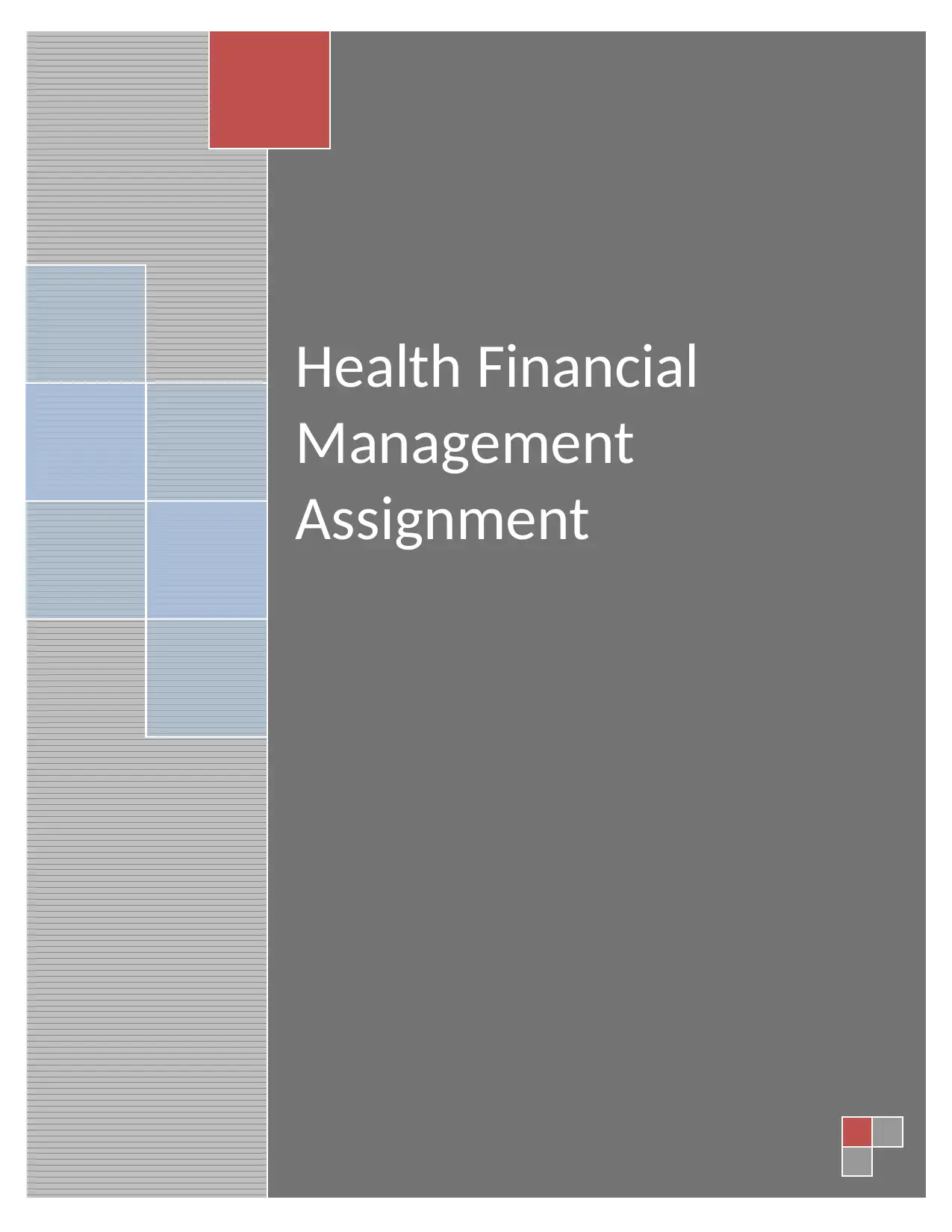
Health Financial
Management
Assignment
Management
Assignment
Secure Best Marks with AI Grader
Need help grading? Try our AI Grader for instant feedback on your assignments.
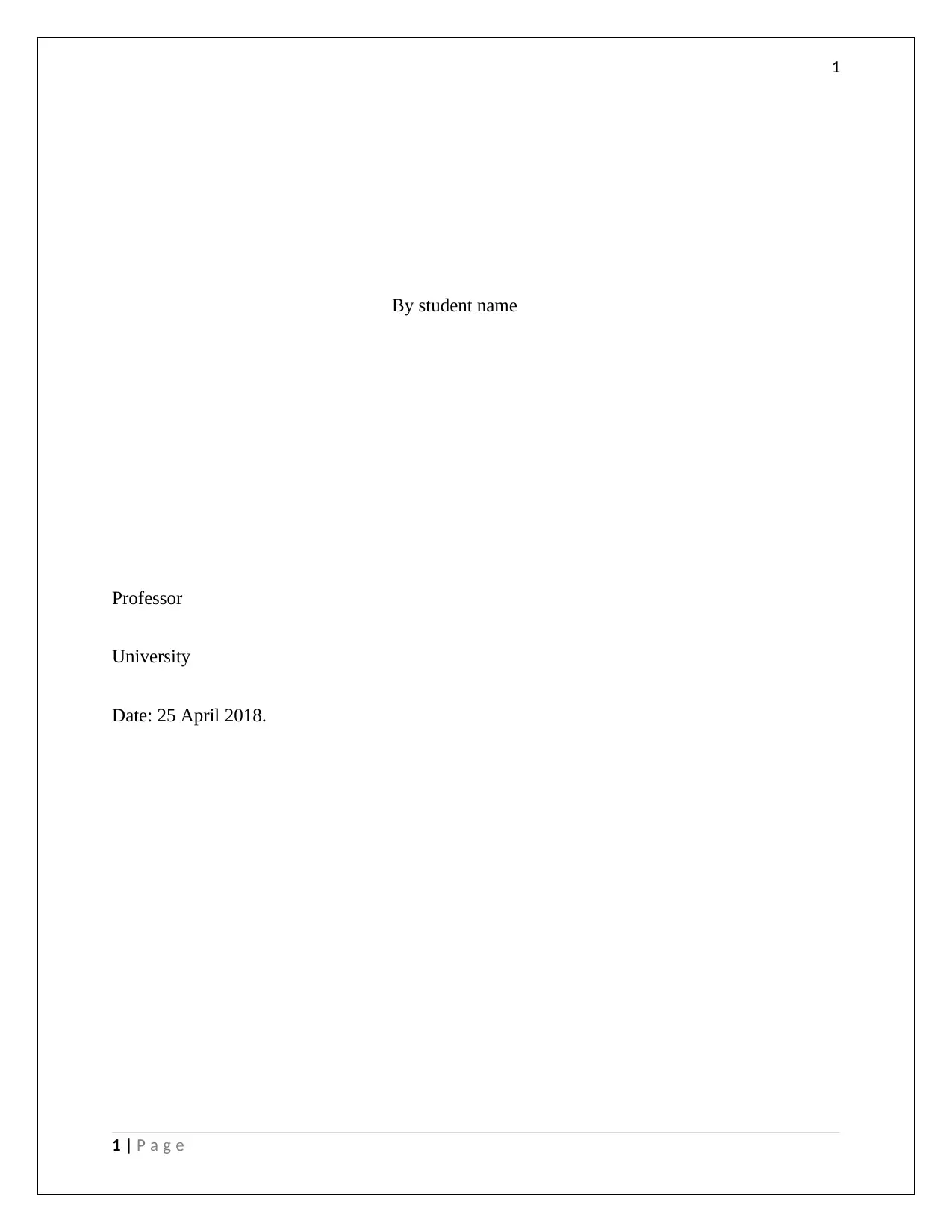
1
By student name
Professor
University
Date: 25 April 2018.
1 | P a g e
By student name
Professor
University
Date: 25 April 2018.
1 | P a g e
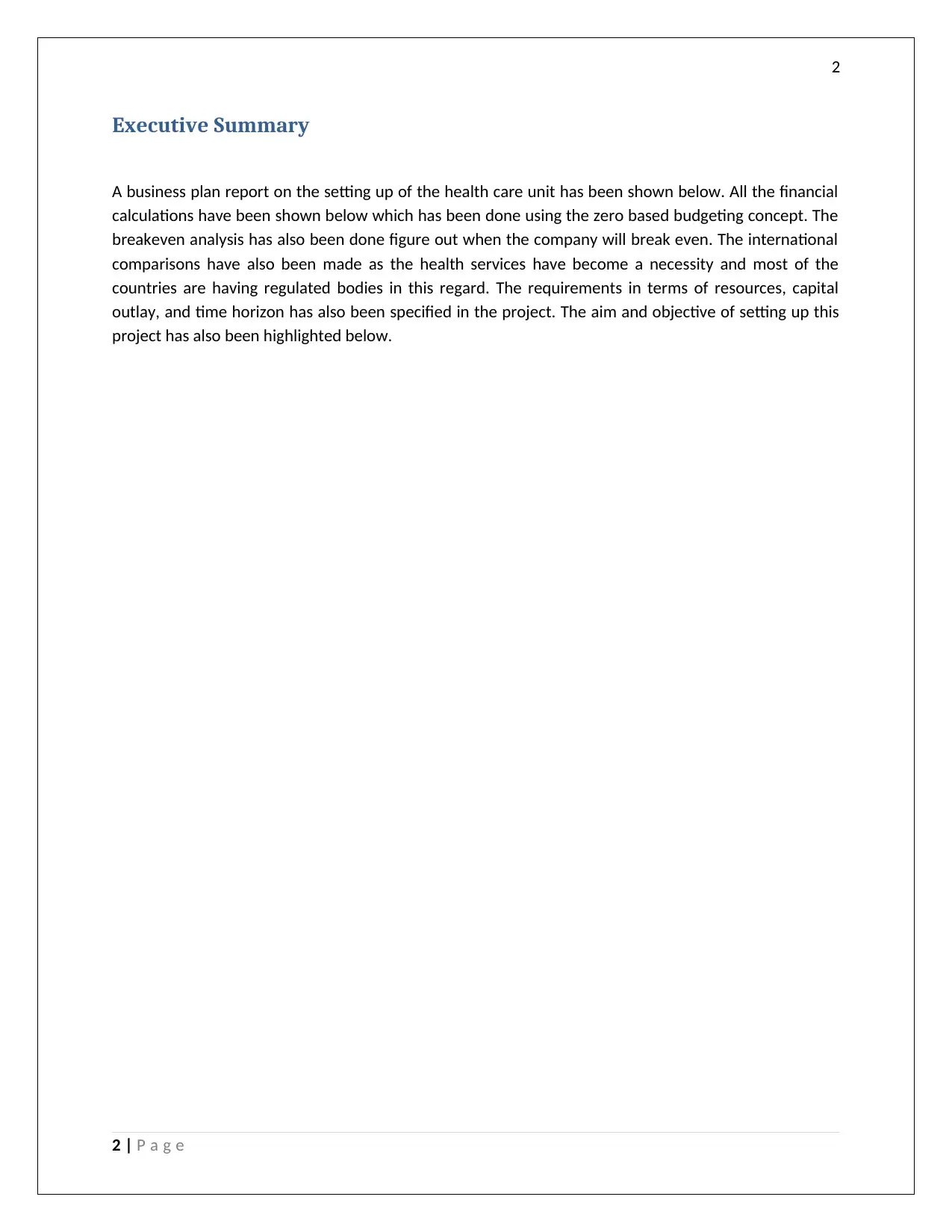
2
Executive Summary
A business plan report on the setting up of the health care unit has been shown below. All the financial
calculations have been shown below which has been done using the zero based budgeting concept. The
breakeven analysis has also been done figure out when the company will break even. The international
comparisons have also been made as the health services have become a necessity and most of the
countries are having regulated bodies in this regard. The requirements in terms of resources, capital
outlay, and time horizon has also been specified in the project. The aim and objective of setting up this
project has also been highlighted below.
2 | P a g e
Executive Summary
A business plan report on the setting up of the health care unit has been shown below. All the financial
calculations have been shown below which has been done using the zero based budgeting concept. The
breakeven analysis has also been done figure out when the company will break even. The international
comparisons have also been made as the health services have become a necessity and most of the
countries are having regulated bodies in this regard. The requirements in terms of resources, capital
outlay, and time horizon has also been specified in the project. The aim and objective of setting up this
project has also been highlighted below.
2 | P a g e
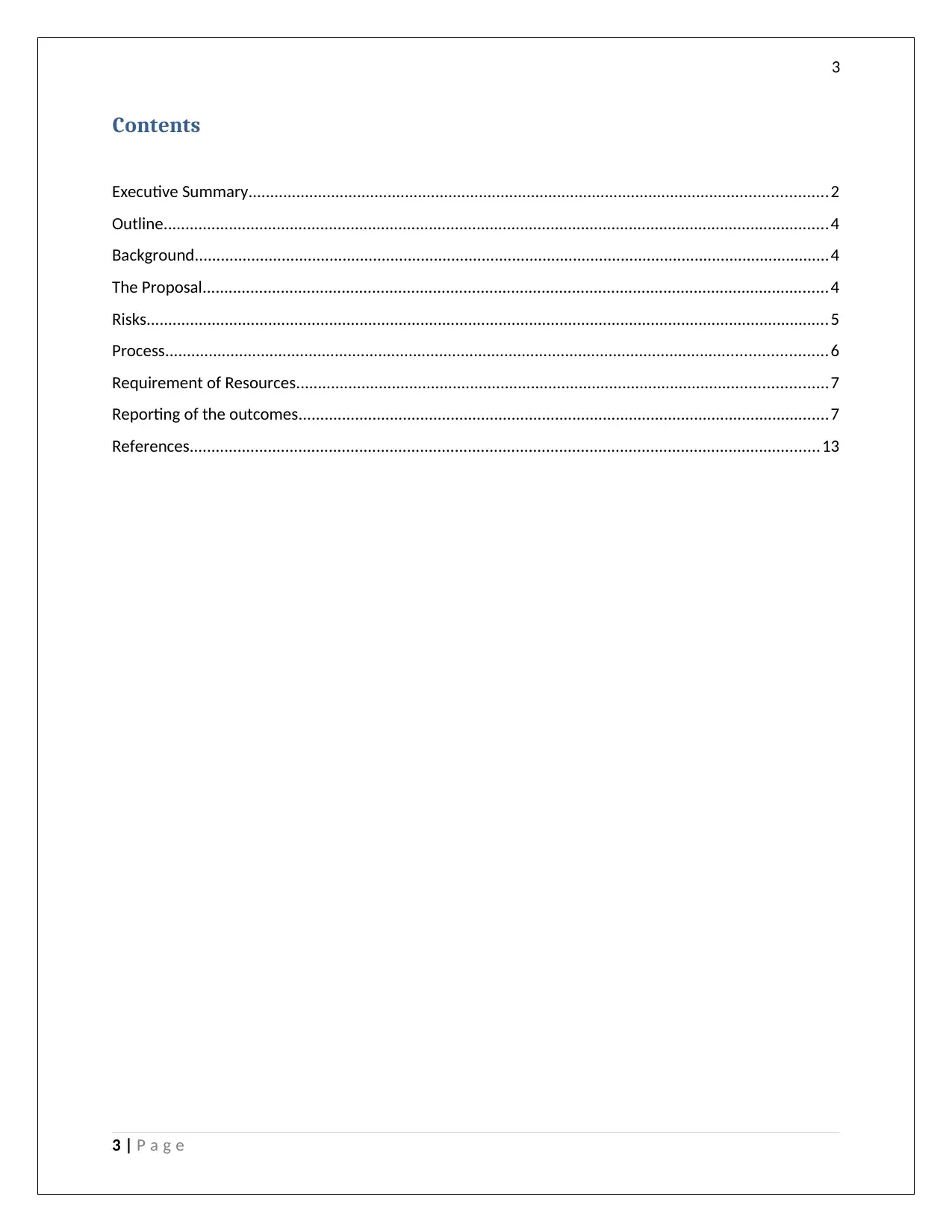
3
Contents
Executive Summary.....................................................................................................................................2
Outline.........................................................................................................................................................4
Background..................................................................................................................................................4
The Proposal................................................................................................................................................4
Risks.............................................................................................................................................................5
Process........................................................................................................................................................6
Requirement of Resources..........................................................................................................................7
Reporting of the outcomes..........................................................................................................................7
References.................................................................................................................................................13
3 | P a g e
Contents
Executive Summary.....................................................................................................................................2
Outline.........................................................................................................................................................4
Background..................................................................................................................................................4
The Proposal................................................................................................................................................4
Risks.............................................................................................................................................................5
Process........................................................................................................................................................6
Requirement of Resources..........................................................................................................................7
Reporting of the outcomes..........................................................................................................................7
References.................................................................................................................................................13
3 | P a g e
Secure Best Marks with AI Grader
Need help grading? Try our AI Grader for instant feedback on your assignments.
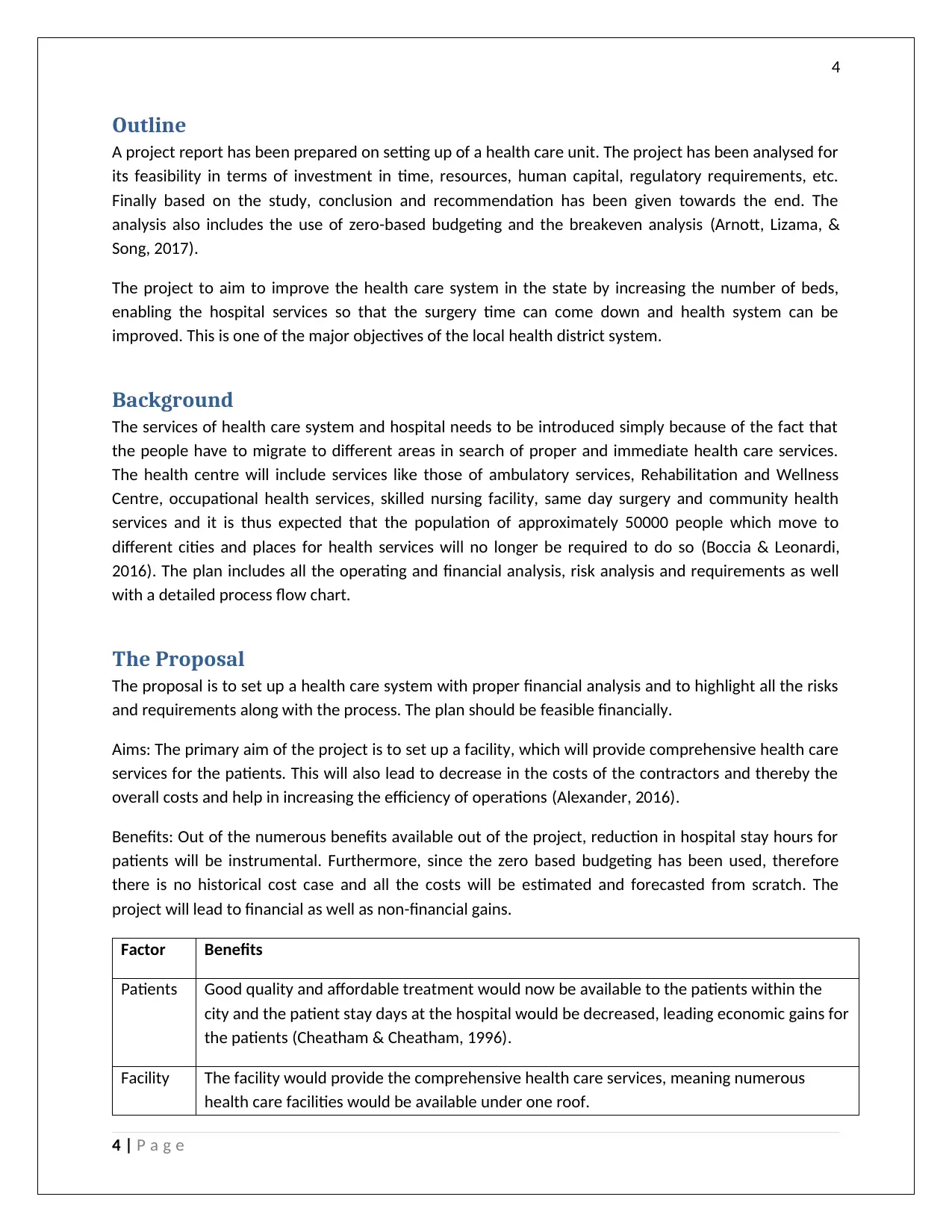
4
Outline
A project report has been prepared on setting up of a health care unit. The project has been analysed for
its feasibility in terms of investment in time, resources, human capital, regulatory requirements, etc.
Finally based on the study, conclusion and recommendation has been given towards the end. The
analysis also includes the use of zero-based budgeting and the breakeven analysis (Arnott, Lizama, &
Song, 2017).
The project to aim to improve the health care system in the state by increasing the number of beds,
enabling the hospital services so that the surgery time can come down and health system can be
improved. This is one of the major objectives of the local health district system.
Background
The services of health care system and hospital needs to be introduced simply because of the fact that
the people have to migrate to different areas in search of proper and immediate health care services.
The health centre will include services like those of ambulatory services, Rehabilitation and Wellness
Centre, occupational health services, skilled nursing facility, same day surgery and community health
services and it is thus expected that the population of approximately 50000 people which move to
different cities and places for health services will no longer be required to do so (Boccia & Leonardi,
2016). The plan includes all the operating and financial analysis, risk analysis and requirements as well
with a detailed process flow chart.
The Proposal
The proposal is to set up a health care system with proper financial analysis and to highlight all the risks
and requirements along with the process. The plan should be feasible financially.
Aims: The primary aim of the project is to set up a facility, which will provide comprehensive health care
services for the patients. This will also lead to decrease in the costs of the contractors and thereby the
overall costs and help in increasing the efficiency of operations (Alexander, 2016).
Benefits: Out of the numerous benefits available out of the project, reduction in hospital stay hours for
patients will be instrumental. Furthermore, since the zero based budgeting has been used, therefore
there is no historical cost case and all the costs will be estimated and forecasted from scratch. The
project will lead to financial as well as non-financial gains.
Factor Benefits
Patients Good quality and affordable treatment would now be available to the patients within the
city and the patient stay days at the hospital would be decreased, leading economic gains for
the patients (Cheatham & Cheatham, 1996).
Facility The facility would provide the comprehensive health care services, meaning numerous
health care facilities would be available under one roof.
4 | P a g e
Outline
A project report has been prepared on setting up of a health care unit. The project has been analysed for
its feasibility in terms of investment in time, resources, human capital, regulatory requirements, etc.
Finally based on the study, conclusion and recommendation has been given towards the end. The
analysis also includes the use of zero-based budgeting and the breakeven analysis (Arnott, Lizama, &
Song, 2017).
The project to aim to improve the health care system in the state by increasing the number of beds,
enabling the hospital services so that the surgery time can come down and health system can be
improved. This is one of the major objectives of the local health district system.
Background
The services of health care system and hospital needs to be introduced simply because of the fact that
the people have to migrate to different areas in search of proper and immediate health care services.
The health centre will include services like those of ambulatory services, Rehabilitation and Wellness
Centre, occupational health services, skilled nursing facility, same day surgery and community health
services and it is thus expected that the population of approximately 50000 people which move to
different cities and places for health services will no longer be required to do so (Boccia & Leonardi,
2016). The plan includes all the operating and financial analysis, risk analysis and requirements as well
with a detailed process flow chart.
The Proposal
The proposal is to set up a health care system with proper financial analysis and to highlight all the risks
and requirements along with the process. The plan should be feasible financially.
Aims: The primary aim of the project is to set up a facility, which will provide comprehensive health care
services for the patients. This will also lead to decrease in the costs of the contractors and thereby the
overall costs and help in increasing the efficiency of operations (Alexander, 2016).
Benefits: Out of the numerous benefits available out of the project, reduction in hospital stay hours for
patients will be instrumental. Furthermore, since the zero based budgeting has been used, therefore
there is no historical cost case and all the costs will be estimated and forecasted from scratch. The
project will lead to financial as well as non-financial gains.
Factor Benefits
Patients Good quality and affordable treatment would now be available to the patients within the
city and the patient stay days at the hospital would be decreased, leading economic gains for
the patients (Cheatham & Cheatham, 1996).
Facility The facility would provide the comprehensive health care services, meaning numerous
health care facilities would be available under one roof.
4 | P a g e
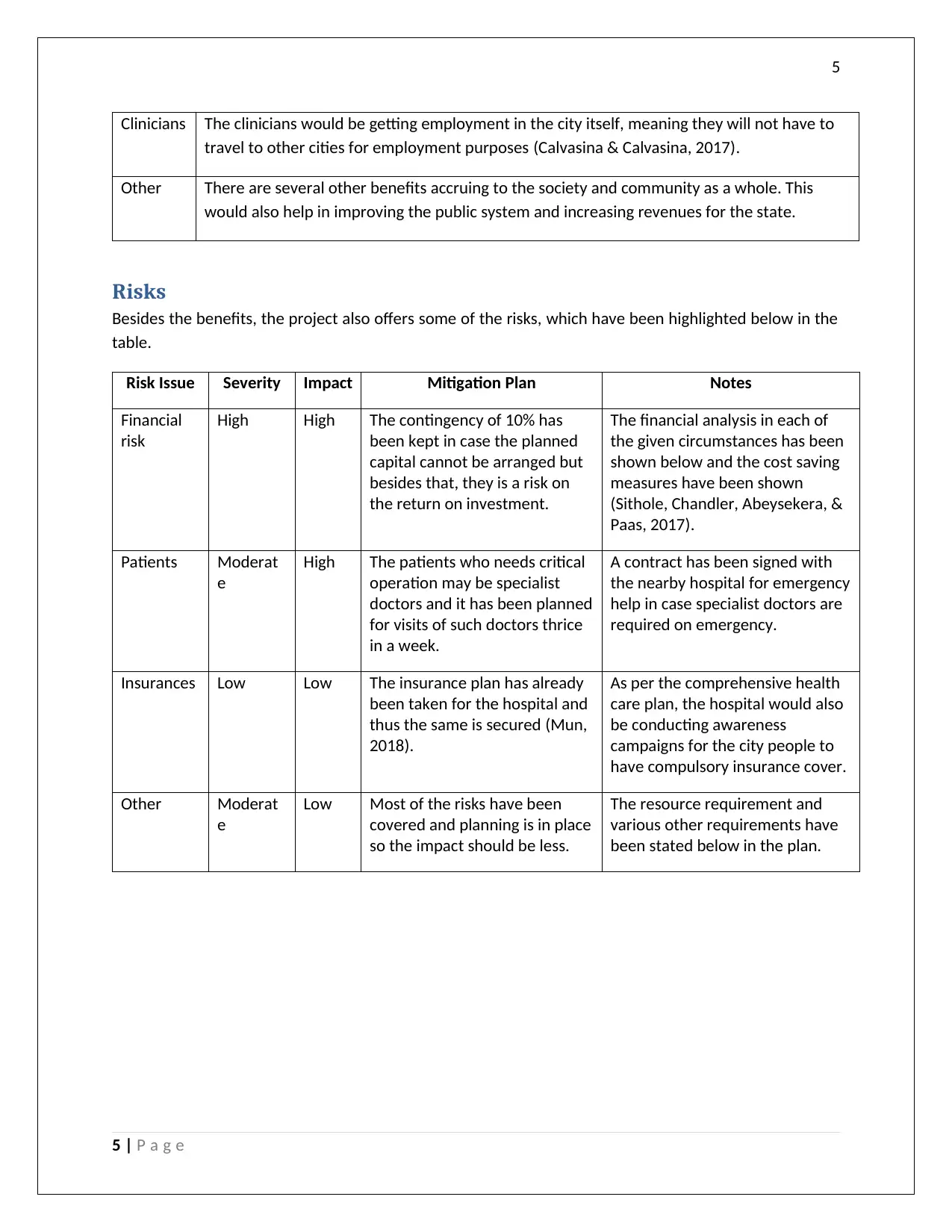
5
Clinicians The clinicians would be getting employment in the city itself, meaning they will not have to
travel to other cities for employment purposes (Calvasina & Calvasina, 2017).
Other There are several other benefits accruing to the society and community as a whole. This
would also help in improving the public system and increasing revenues for the state.
Risks
Besides the benefits, the project also offers some of the risks, which have been highlighted below in the
table.
Risk Issue Severity Impact Mitigation Plan Notes
Financial
risk
High High The contingency of 10% has
been kept in case the planned
capital cannot be arranged but
besides that, they is a risk on
the return on investment.
The financial analysis in each of
the given circumstances has been
shown below and the cost saving
measures have been shown
(Sithole, Chandler, Abeysekera, &
Paas, 2017).
Patients Moderat
e
High The patients who needs critical
operation may be specialist
doctors and it has been planned
for visits of such doctors thrice
in a week.
A contract has been signed with
the nearby hospital for emergency
help in case specialist doctors are
required on emergency.
Insurances Low Low The insurance plan has already
been taken for the hospital and
thus the same is secured (Mun,
2018).
As per the comprehensive health
care plan, the hospital would also
be conducting awareness
campaigns for the city people to
have compulsory insurance cover.
Other Moderat
e
Low Most of the risks have been
covered and planning is in place
so the impact should be less.
The resource requirement and
various other requirements have
been stated below in the plan.
5 | P a g e
Clinicians The clinicians would be getting employment in the city itself, meaning they will not have to
travel to other cities for employment purposes (Calvasina & Calvasina, 2017).
Other There are several other benefits accruing to the society and community as a whole. This
would also help in improving the public system and increasing revenues for the state.
Risks
Besides the benefits, the project also offers some of the risks, which have been highlighted below in the
table.
Risk Issue Severity Impact Mitigation Plan Notes
Financial
risk
High High The contingency of 10% has
been kept in case the planned
capital cannot be arranged but
besides that, they is a risk on
the return on investment.
The financial analysis in each of
the given circumstances has been
shown below and the cost saving
measures have been shown
(Sithole, Chandler, Abeysekera, &
Paas, 2017).
Patients Moderat
e
High The patients who needs critical
operation may be specialist
doctors and it has been planned
for visits of such doctors thrice
in a week.
A contract has been signed with
the nearby hospital for emergency
help in case specialist doctors are
required on emergency.
Insurances Low Low The insurance plan has already
been taken for the hospital and
thus the same is secured (Mun,
2018).
As per the comprehensive health
care plan, the hospital would also
be conducting awareness
campaigns for the city people to
have compulsory insurance cover.
Other Moderat
e
Low Most of the risks have been
covered and planning is in place
so the impact should be less.
The resource requirement and
various other requirements have
been stated below in the plan.
5 | P a g e
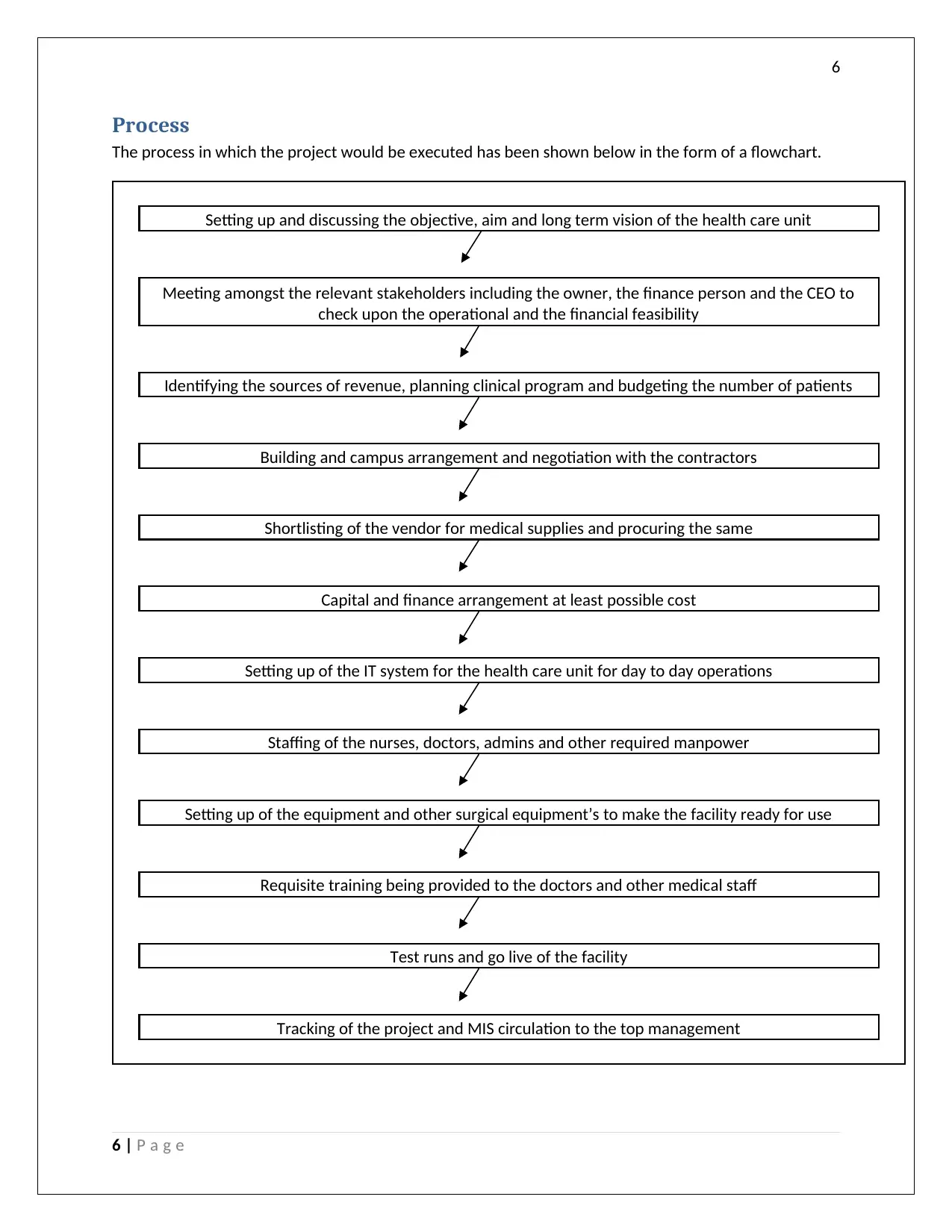
6
Process
The process in which the project would be executed has been shown below in the form of a flowchart.
Setting up and discussing the objective, aim and long term vision of the health care unit
Meeting amongst the relevant stakeholders including the owner, the finance person and the CEO to
check upon the operational and the financial feasibility
Identifying the sources of revenue, planning clinical program and budgeting the number of patients
Building and campus arrangement and negotiation with the contractors
Shortlisting of the vendor for medical supplies and procuring the same
Capital and finance arrangement at least possible cost
Setting up of the IT system for the health care unit for day to day operations
Staffing of the nurses, doctors, admins and other required manpower
Setting up of the equipment and other surgical equipment’s to make the facility ready for use
Requisite training being provided to the doctors and other medical staff
Test runs and go live of the facility
Tracking of the project and MIS circulation to the top management
6 | P a g e
Process
The process in which the project would be executed has been shown below in the form of a flowchart.
Setting up and discussing the objective, aim and long term vision of the health care unit
Meeting amongst the relevant stakeholders including the owner, the finance person and the CEO to
check upon the operational and the financial feasibility
Identifying the sources of revenue, planning clinical program and budgeting the number of patients
Building and campus arrangement and negotiation with the contractors
Shortlisting of the vendor for medical supplies and procuring the same
Capital and finance arrangement at least possible cost
Setting up of the IT system for the health care unit for day to day operations
Staffing of the nurses, doctors, admins and other required manpower
Setting up of the equipment and other surgical equipment’s to make the facility ready for use
Requisite training being provided to the doctors and other medical staff
Test runs and go live of the facility
Tracking of the project and MIS circulation to the top management
6 | P a g e
Paraphrase This Document
Need a fresh take? Get an instant paraphrase of this document with our AI Paraphraser
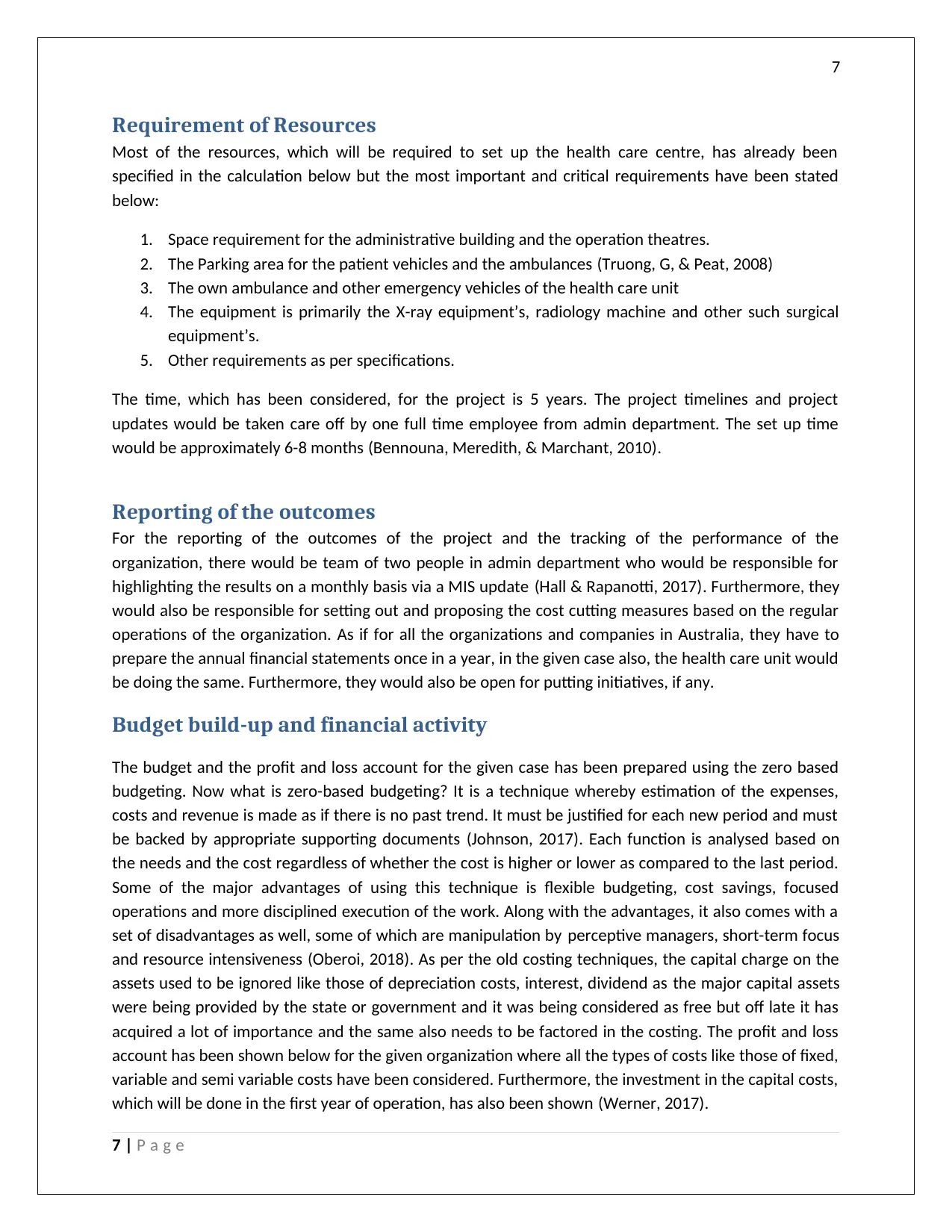
7
Requirement of Resources
Most of the resources, which will be required to set up the health care centre, has already been
specified in the calculation below but the most important and critical requirements have been stated
below:
1. Space requirement for the administrative building and the operation theatres.
2. The Parking area for the patient vehicles and the ambulances (Truong, G, & Peat, 2008)
3. The own ambulance and other emergency vehicles of the health care unit
4. The equipment is primarily the X-ray equipment’s, radiology machine and other such surgical
equipment’s.
5. Other requirements as per specifications.
The time, which has been considered, for the project is 5 years. The project timelines and project
updates would be taken care off by one full time employee from admin department. The set up time
would be approximately 6-8 months (Bennouna, Meredith, & Marchant, 2010).
Reporting of the outcomes
For the reporting of the outcomes of the project and the tracking of the performance of the
organization, there would be team of two people in admin department who would be responsible for
highlighting the results on a monthly basis via a MIS update (Hall & Rapanotti, 2017). Furthermore, they
would also be responsible for setting out and proposing the cost cutting measures based on the regular
operations of the organization. As if for all the organizations and companies in Australia, they have to
prepare the annual financial statements once in a year, in the given case also, the health care unit would
be doing the same. Furthermore, they would also be open for putting initiatives, if any.
Budget build-up and financial activity
The budget and the profit and loss account for the given case has been prepared using the zero based
budgeting. Now what is zero-based budgeting? It is a technique whereby estimation of the expenses,
costs and revenue is made as if there is no past trend. It must be justified for each new period and must
be backed by appropriate supporting documents (Johnson, 2017). Each function is analysed based on
the needs and the cost regardless of whether the cost is higher or lower as compared to the last period.
Some of the major advantages of using this technique is flexible budgeting, cost savings, focused
operations and more disciplined execution of the work. Along with the advantages, it also comes with a
set of disadvantages as well, some of which are manipulation by perceptive managers, short-term focus
and resource intensiveness (Oberoi, 2018). As per the old costing techniques, the capital charge on the
assets used to be ignored like those of depreciation costs, interest, dividend as the major capital assets
were being provided by the state or government and it was being considered as free but off late it has
acquired a lot of importance and the same also needs to be factored in the costing. The profit and loss
account has been shown below for the given organization where all the types of costs like those of fixed,
variable and semi variable costs have been considered. Furthermore, the investment in the capital costs,
which will be done in the first year of operation, has also been shown (Werner, 2017).
7 | P a g e
Requirement of Resources
Most of the resources, which will be required to set up the health care centre, has already been
specified in the calculation below but the most important and critical requirements have been stated
below:
1. Space requirement for the administrative building and the operation theatres.
2. The Parking area for the patient vehicles and the ambulances (Truong, G, & Peat, 2008)
3. The own ambulance and other emergency vehicles of the health care unit
4. The equipment is primarily the X-ray equipment’s, radiology machine and other such surgical
equipment’s.
5. Other requirements as per specifications.
The time, which has been considered, for the project is 5 years. The project timelines and project
updates would be taken care off by one full time employee from admin department. The set up time
would be approximately 6-8 months (Bennouna, Meredith, & Marchant, 2010).
Reporting of the outcomes
For the reporting of the outcomes of the project and the tracking of the performance of the
organization, there would be team of two people in admin department who would be responsible for
highlighting the results on a monthly basis via a MIS update (Hall & Rapanotti, 2017). Furthermore, they
would also be responsible for setting out and proposing the cost cutting measures based on the regular
operations of the organization. As if for all the organizations and companies in Australia, they have to
prepare the annual financial statements once in a year, in the given case also, the health care unit would
be doing the same. Furthermore, they would also be open for putting initiatives, if any.
Budget build-up and financial activity
The budget and the profit and loss account for the given case has been prepared using the zero based
budgeting. Now what is zero-based budgeting? It is a technique whereby estimation of the expenses,
costs and revenue is made as if there is no past trend. It must be justified for each new period and must
be backed by appropriate supporting documents (Johnson, 2017). Each function is analysed based on
the needs and the cost regardless of whether the cost is higher or lower as compared to the last period.
Some of the major advantages of using this technique is flexible budgeting, cost savings, focused
operations and more disciplined execution of the work. Along with the advantages, it also comes with a
set of disadvantages as well, some of which are manipulation by perceptive managers, short-term focus
and resource intensiveness (Oberoi, 2018). As per the old costing techniques, the capital charge on the
assets used to be ignored like those of depreciation costs, interest, dividend as the major capital assets
were being provided by the state or government and it was being considered as free but off late it has
acquired a lot of importance and the same also needs to be factored in the costing. The profit and loss
account has been shown below for the given organization where all the types of costs like those of fixed,
variable and semi variable costs have been considered. Furthermore, the investment in the capital costs,
which will be done in the first year of operation, has also been shown (Werner, 2017).
7 | P a g e
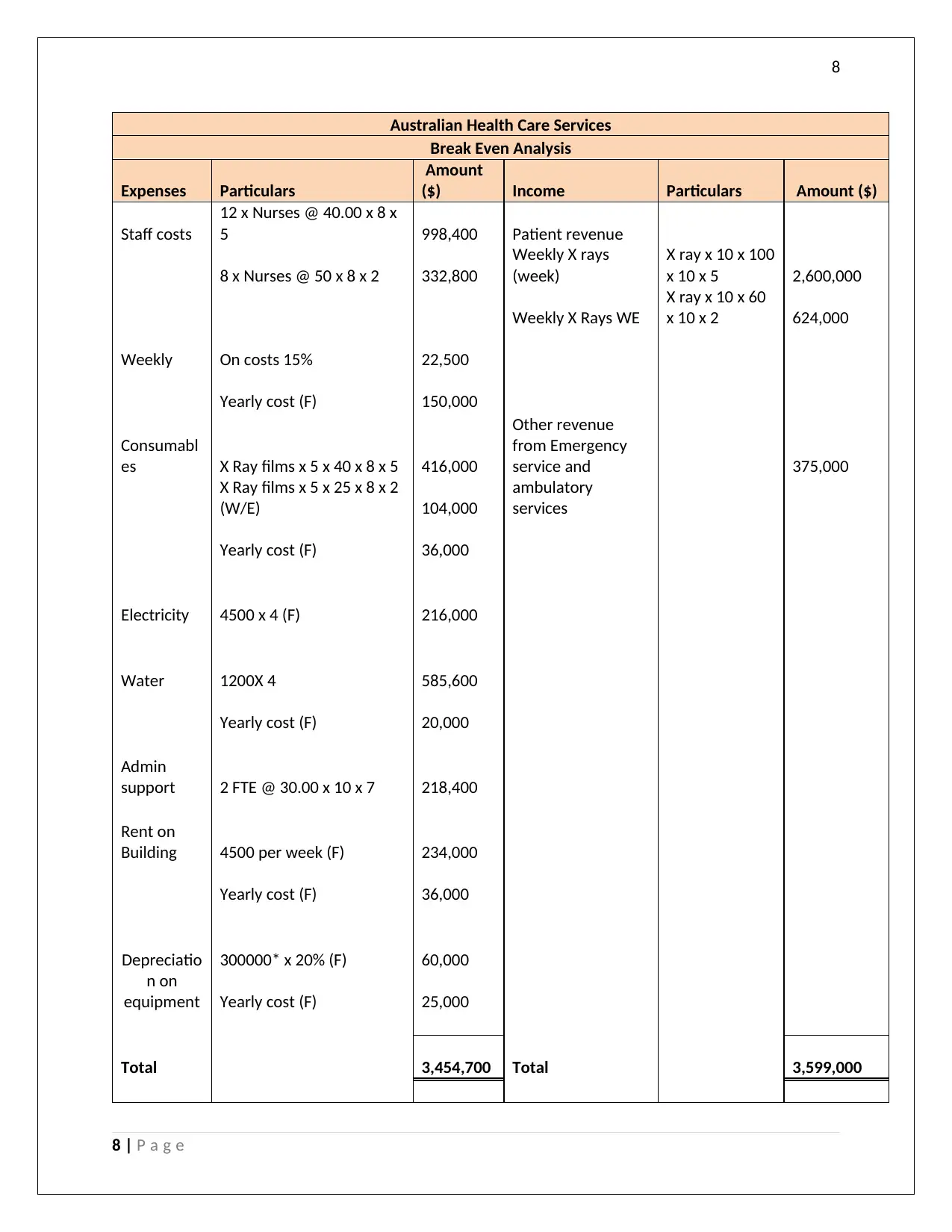
8
Australian Health Care Services
Break Even Analysis
Expenses Particulars
Amount
($) Income Particulars Amount ($)
Staff costs
12 x Nurses @ 40.00 x 8 x
5 998,400 Patient revenue
8 x Nurses @ 50 x 8 x 2 332,800
Weekly X rays
(week)
X ray x 10 x 100
x 10 x 5 2,600,000
Weekly X Rays WE
X ray x 10 x 60
x 10 x 2 624,000
Weekly On costs 15% 22,500
Yearly cost (F) 150,000
Other revenue
from Emergency
service and
ambulatory
services
Consumabl
es X Ray films x 5 x 40 x 8 x 5 416,000 375,000
X Ray films x 5 x 25 x 8 x 2
(W/E) 104,000
Yearly cost (F) 36,000
Electricity 4500 x 4 (F) 216,000
Water 1200X 4 585,600
Yearly cost (F) 20,000
Admin
support 2 FTE @ 30.00 x 10 x 7 218,400
Rent on
Building 4500 per week (F) 234,000
Yearly cost (F) 36,000
Depreciatio
n on
equipment
300000* x 20% (F) 60,000
Yearly cost (F) 25,000
Total 3,454,700 Total 3,599,000
8 | P a g e
Australian Health Care Services
Break Even Analysis
Expenses Particulars
Amount
($) Income Particulars Amount ($)
Staff costs
12 x Nurses @ 40.00 x 8 x
5 998,400 Patient revenue
8 x Nurses @ 50 x 8 x 2 332,800
Weekly X rays
(week)
X ray x 10 x 100
x 10 x 5 2,600,000
Weekly X Rays WE
X ray x 10 x 60
x 10 x 2 624,000
Weekly On costs 15% 22,500
Yearly cost (F) 150,000
Other revenue
from Emergency
service and
ambulatory
services
Consumabl
es X Ray films x 5 x 40 x 8 x 5 416,000 375,000
X Ray films x 5 x 25 x 8 x 2
(W/E) 104,000
Yearly cost (F) 36,000
Electricity 4500 x 4 (F) 216,000
Water 1200X 4 585,600
Yearly cost (F) 20,000
Admin
support 2 FTE @ 30.00 x 10 x 7 218,400
Rent on
Building 4500 per week (F) 234,000
Yearly cost (F) 36,000
Depreciatio
n on
equipment
300000* x 20% (F) 60,000
Yearly cost (F) 25,000
Total 3,454,700 Total 3,599,000
8 | P a g e
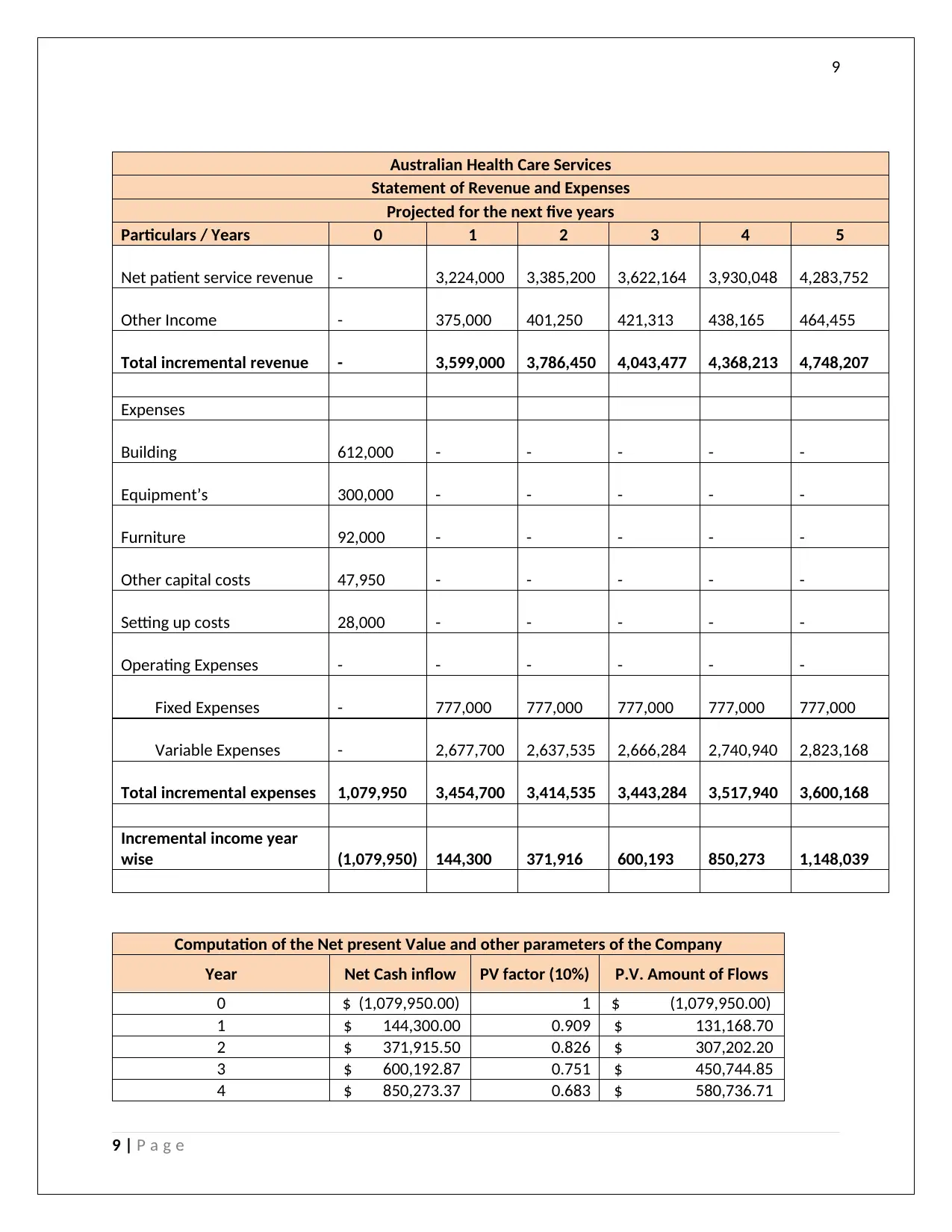
9
Australian Health Care Services
Statement of Revenue and Expenses
Projected for the next five years
Particulars / Years 0 1 2 3 4 5
Net patient service revenue - 3,224,000 3,385,200 3,622,164 3,930,048 4,283,752
Other Income - 375,000 401,250 421,313 438,165 464,455
Total incremental revenue - 3,599,000 3,786,450 4,043,477 4,368,213 4,748,207
Expenses
Building 612,000 - - - - -
Equipment’s 300,000 - - - - -
Furniture 92,000 - - - - -
Other capital costs 47,950 - - - - -
Setting up costs 28,000 - - - - -
Operating Expenses - - - - - -
Fixed Expenses - 777,000 777,000 777,000 777,000 777,000
Variable Expenses - 2,677,700 2,637,535 2,666,284 2,740,940 2,823,168
Total incremental expenses 1,079,950 3,454,700 3,414,535 3,443,284 3,517,940 3,600,168
Incremental income year
wise (1,079,950) 144,300 371,916 600,193 850,273 1,148,039
Computation of the Net present Value and other parameters of the Company
Year Net Cash inflow PV factor (10%) P.V. Amount of Flows
0 $ (1,079,950.00) 1 $ (1,079,950.00)
1 $ 144,300.00 0.909 $ 131,168.70
2 $ 371,915.50 0.826 $ 307,202.20
3 $ 600,192.87 0.751 $ 450,744.85
4 $ 850,273.37 0.683 $ 580,736.71
9 | P a g e
Australian Health Care Services
Statement of Revenue and Expenses
Projected for the next five years
Particulars / Years 0 1 2 3 4 5
Net patient service revenue - 3,224,000 3,385,200 3,622,164 3,930,048 4,283,752
Other Income - 375,000 401,250 421,313 438,165 464,455
Total incremental revenue - 3,599,000 3,786,450 4,043,477 4,368,213 4,748,207
Expenses
Building 612,000 - - - - -
Equipment’s 300,000 - - - - -
Furniture 92,000 - - - - -
Other capital costs 47,950 - - - - -
Setting up costs 28,000 - - - - -
Operating Expenses - - - - - -
Fixed Expenses - 777,000 777,000 777,000 777,000 777,000
Variable Expenses - 2,677,700 2,637,535 2,666,284 2,740,940 2,823,168
Total incremental expenses 1,079,950 3,454,700 3,414,535 3,443,284 3,517,940 3,600,168
Incremental income year
wise (1,079,950) 144,300 371,916 600,193 850,273 1,148,039
Computation of the Net present Value and other parameters of the Company
Year Net Cash inflow PV factor (10%) P.V. Amount of Flows
0 $ (1,079,950.00) 1 $ (1,079,950.00)
1 $ 144,300.00 0.909 $ 131,168.70
2 $ 371,915.50 0.826 $ 307,202.20
3 $ 600,192.87 0.751 $ 450,744.85
4 $ 850,273.37 0.683 $ 580,736.71
9 | P a g e
Secure Best Marks with AI Grader
Need help grading? Try our AI Grader for instant feedback on your assignments.
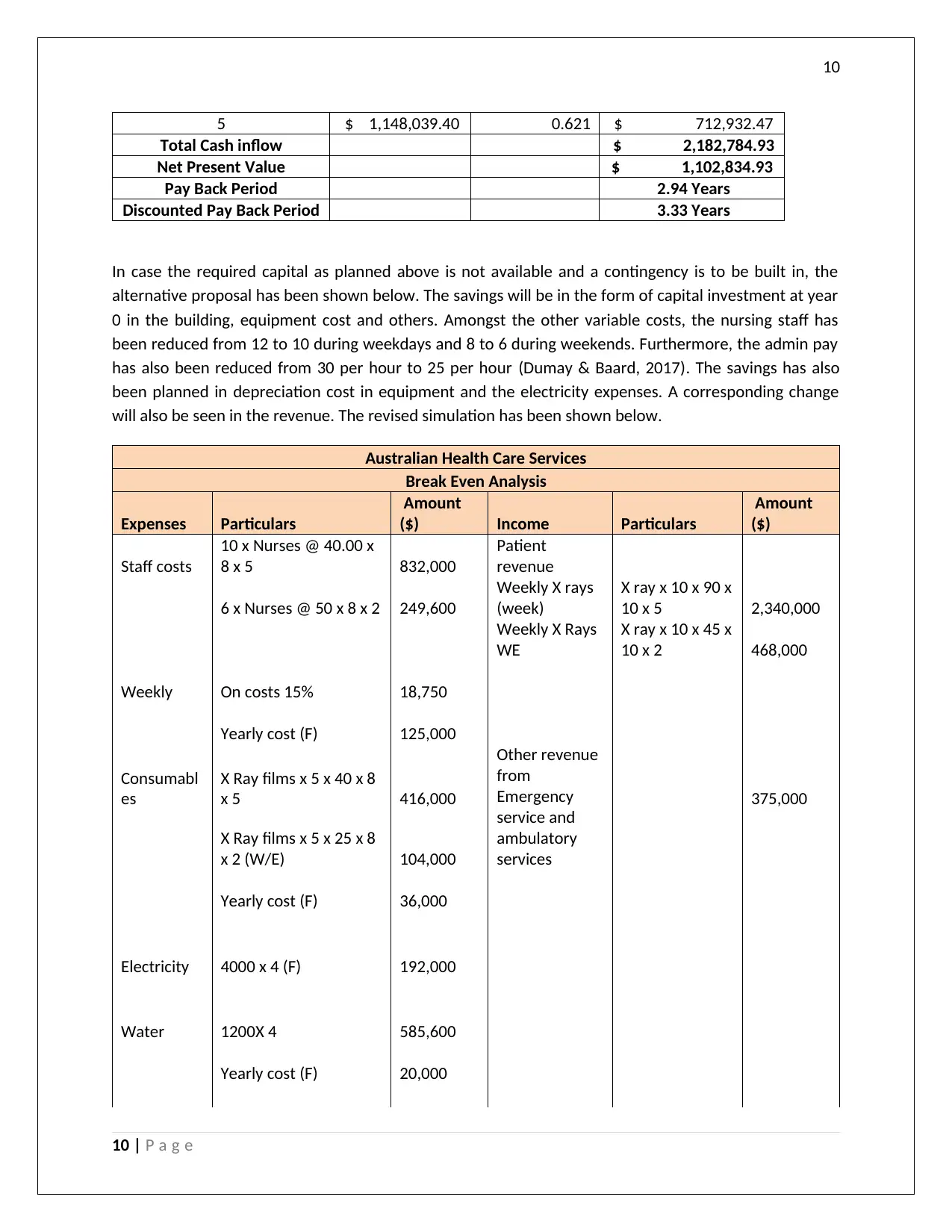
10
5 $ 1,148,039.40 0.621 $ 712,932.47
Total Cash inflow $ 2,182,784.93
Net Present Value $ 1,102,834.93
Pay Back Period 2.94 Years
Discounted Pay Back Period 3.33 Years
In case the required capital as planned above is not available and a contingency is to be built in, the
alternative proposal has been shown below. The savings will be in the form of capital investment at year
0 in the building, equipment cost and others. Amongst the other variable costs, the nursing staff has
been reduced from 12 to 10 during weekdays and 8 to 6 during weekends. Furthermore, the admin pay
has also been reduced from 30 per hour to 25 per hour (Dumay & Baard, 2017). The savings has also
been planned in depreciation cost in equipment and the electricity expenses. A corresponding change
will also be seen in the revenue. The revised simulation has been shown below.
Australian Health Care Services
Break Even Analysis
Expenses Particulars
Amount
($) Income Particulars
Amount
($)
Staff costs
10 x Nurses @ 40.00 x
8 x 5 832,000
Patient
revenue
6 x Nurses @ 50 x 8 x 2 249,600
Weekly X rays
(week)
X ray x 10 x 90 x
10 x 5 2,340,000
Weekly X Rays
WE
X ray x 10 x 45 x
10 x 2 468,000
Weekly On costs 15% 18,750
Yearly cost (F) 125,000
Other revenue
from
Emergency
service and
ambulatory
services
Consumabl
es
X Ray films x 5 x 40 x 8
x 5 416,000 375,000
X Ray films x 5 x 25 x 8
x 2 (W/E) 104,000
Yearly cost (F) 36,000
Electricity 4000 x 4 (F) 192,000
Water 1200X 4 585,600
Yearly cost (F) 20,000
10 | P a g e
5 $ 1,148,039.40 0.621 $ 712,932.47
Total Cash inflow $ 2,182,784.93
Net Present Value $ 1,102,834.93
Pay Back Period 2.94 Years
Discounted Pay Back Period 3.33 Years
In case the required capital as planned above is not available and a contingency is to be built in, the
alternative proposal has been shown below. The savings will be in the form of capital investment at year
0 in the building, equipment cost and others. Amongst the other variable costs, the nursing staff has
been reduced from 12 to 10 during weekdays and 8 to 6 during weekends. Furthermore, the admin pay
has also been reduced from 30 per hour to 25 per hour (Dumay & Baard, 2017). The savings has also
been planned in depreciation cost in equipment and the electricity expenses. A corresponding change
will also be seen in the revenue. The revised simulation has been shown below.
Australian Health Care Services
Break Even Analysis
Expenses Particulars
Amount
($) Income Particulars
Amount
($)
Staff costs
10 x Nurses @ 40.00 x
8 x 5 832,000
Patient
revenue
6 x Nurses @ 50 x 8 x 2 249,600
Weekly X rays
(week)
X ray x 10 x 90 x
10 x 5 2,340,000
Weekly X Rays
WE
X ray x 10 x 45 x
10 x 2 468,000
Weekly On costs 15% 18,750
Yearly cost (F) 125,000
Other revenue
from
Emergency
service and
ambulatory
services
Consumabl
es
X Ray films x 5 x 40 x 8
x 5 416,000 375,000
X Ray films x 5 x 25 x 8
x 2 (W/E) 104,000
Yearly cost (F) 36,000
Electricity 4000 x 4 (F) 192,000
Water 1200X 4 585,600
Yearly cost (F) 20,000
10 | P a g e
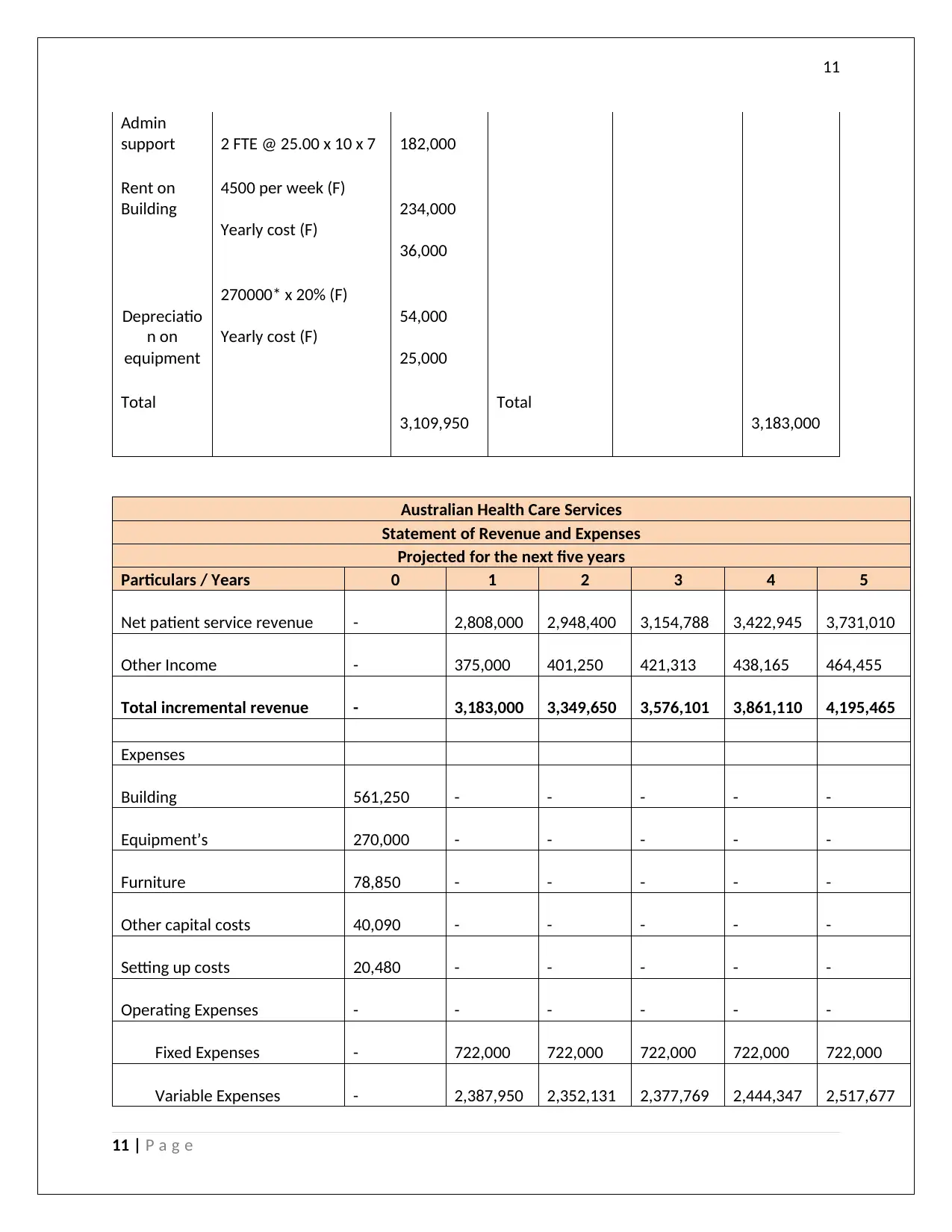
11
Admin
support 2 FTE @ 25.00 x 10 x 7 182,000
Rent on
Building
4500 per week (F)
234,000
Yearly cost (F)
36,000
Depreciatio
n on
equipment
270000* x 20% (F)
54,000
Yearly cost (F)
25,000
Total
3,109,950
Total
3,183,000
Australian Health Care Services
Statement of Revenue and Expenses
Projected for the next five years
Particulars / Years 0 1 2 3 4 5
Net patient service revenue - 2,808,000 2,948,400 3,154,788 3,422,945 3,731,010
Other Income - 375,000 401,250 421,313 438,165 464,455
Total incremental revenue - 3,183,000 3,349,650 3,576,101 3,861,110 4,195,465
Expenses
Building 561,250 - - - - -
Equipment’s 270,000 - - - - -
Furniture 78,850 - - - - -
Other capital costs 40,090 - - - - -
Setting up costs 20,480 - - - - -
Operating Expenses - - - - - -
Fixed Expenses - 722,000 722,000 722,000 722,000 722,000
Variable Expenses - 2,387,950 2,352,131 2,377,769 2,444,347 2,517,677
11 | P a g e
Admin
support 2 FTE @ 25.00 x 10 x 7 182,000
Rent on
Building
4500 per week (F)
234,000
Yearly cost (F)
36,000
Depreciatio
n on
equipment
270000* x 20% (F)
54,000
Yearly cost (F)
25,000
Total
3,109,950
Total
3,183,000
Australian Health Care Services
Statement of Revenue and Expenses
Projected for the next five years
Particulars / Years 0 1 2 3 4 5
Net patient service revenue - 2,808,000 2,948,400 3,154,788 3,422,945 3,731,010
Other Income - 375,000 401,250 421,313 438,165 464,455
Total incremental revenue - 3,183,000 3,349,650 3,576,101 3,861,110 4,195,465
Expenses
Building 561,250 - - - - -
Equipment’s 270,000 - - - - -
Furniture 78,850 - - - - -
Other capital costs 40,090 - - - - -
Setting up costs 20,480 - - - - -
Operating Expenses - - - - - -
Fixed Expenses - 722,000 722,000 722,000 722,000 722,000
Variable Expenses - 2,387,950 2,352,131 2,377,769 2,444,347 2,517,677
11 | P a g e
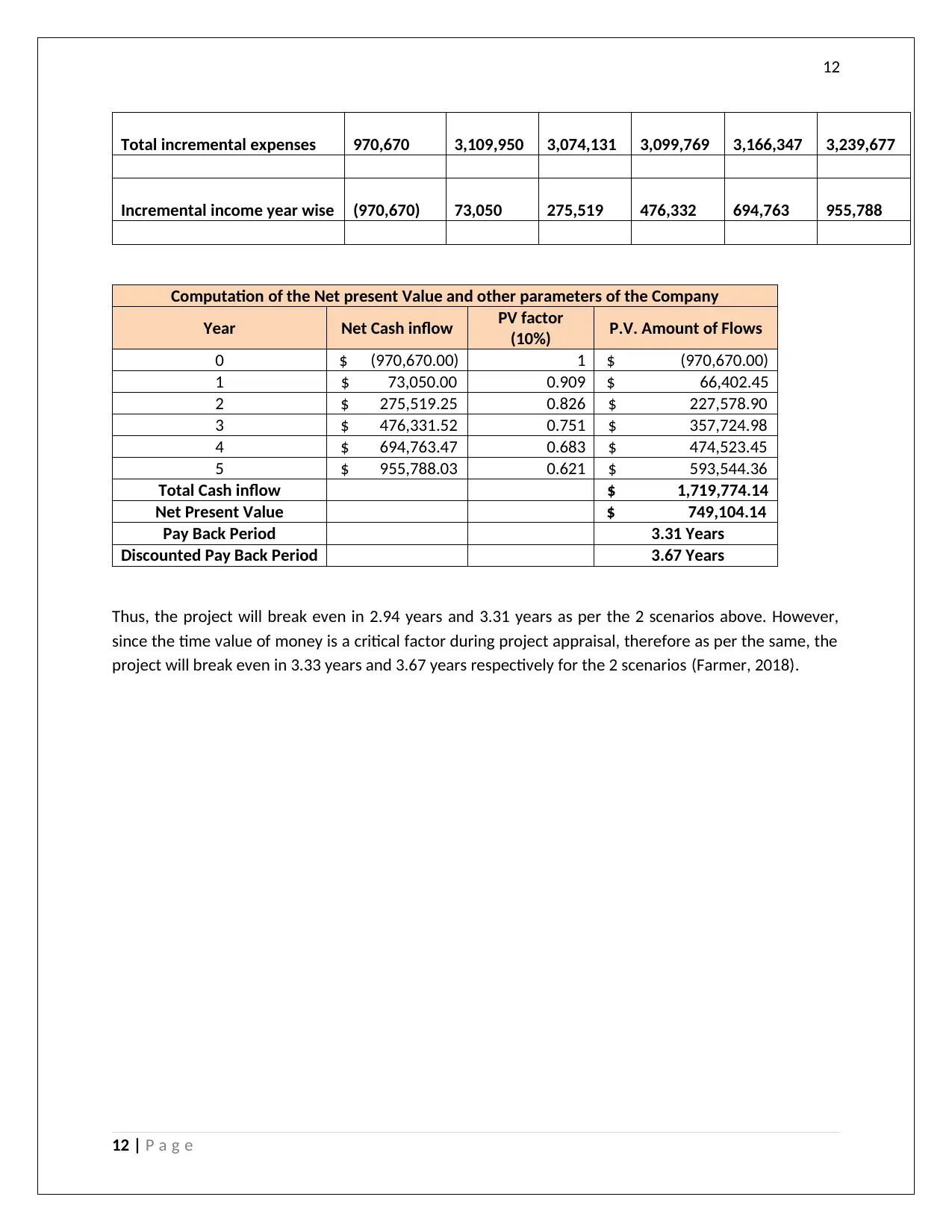
12
Total incremental expenses 970,670 3,109,950 3,074,131 3,099,769 3,166,347 3,239,677
Incremental income year wise (970,670) 73,050 275,519 476,332 694,763 955,788
Computation of the Net present Value and other parameters of the Company
Year Net Cash inflow PV factor
(10%) P.V. Amount of Flows
0 $ (970,670.00) 1 $ (970,670.00)
1 $ 73,050.00 0.909 $ 66,402.45
2 $ 275,519.25 0.826 $ 227,578.90
3 $ 476,331.52 0.751 $ 357,724.98
4 $ 694,763.47 0.683 $ 474,523.45
5 $ 955,788.03 0.621 $ 593,544.36
Total Cash inflow $ 1,719,774.14
Net Present Value $ 749,104.14
Pay Back Period 3.31 Years
Discounted Pay Back Period 3.67 Years
Thus, the project will break even in 2.94 years and 3.31 years as per the 2 scenarios above. However,
since the time value of money is a critical factor during project appraisal, therefore as per the same, the
project will break even in 3.33 years and 3.67 years respectively for the 2 scenarios (Farmer, 2018).
12 | P a g e
Total incremental expenses 970,670 3,109,950 3,074,131 3,099,769 3,166,347 3,239,677
Incremental income year wise (970,670) 73,050 275,519 476,332 694,763 955,788
Computation of the Net present Value and other parameters of the Company
Year Net Cash inflow PV factor
(10%) P.V. Amount of Flows
0 $ (970,670.00) 1 $ (970,670.00)
1 $ 73,050.00 0.909 $ 66,402.45
2 $ 275,519.25 0.826 $ 227,578.90
3 $ 476,331.52 0.751 $ 357,724.98
4 $ 694,763.47 0.683 $ 474,523.45
5 $ 955,788.03 0.621 $ 593,544.36
Total Cash inflow $ 1,719,774.14
Net Present Value $ 749,104.14
Pay Back Period 3.31 Years
Discounted Pay Back Period 3.67 Years
Thus, the project will break even in 2.94 years and 3.31 years as per the 2 scenarios above. However,
since the time value of money is a critical factor during project appraisal, therefore as per the same, the
project will break even in 3.33 years and 3.67 years respectively for the 2 scenarios (Farmer, 2018).
12 | P a g e
Paraphrase This Document
Need a fresh take? Get an instant paraphrase of this document with our AI Paraphraser
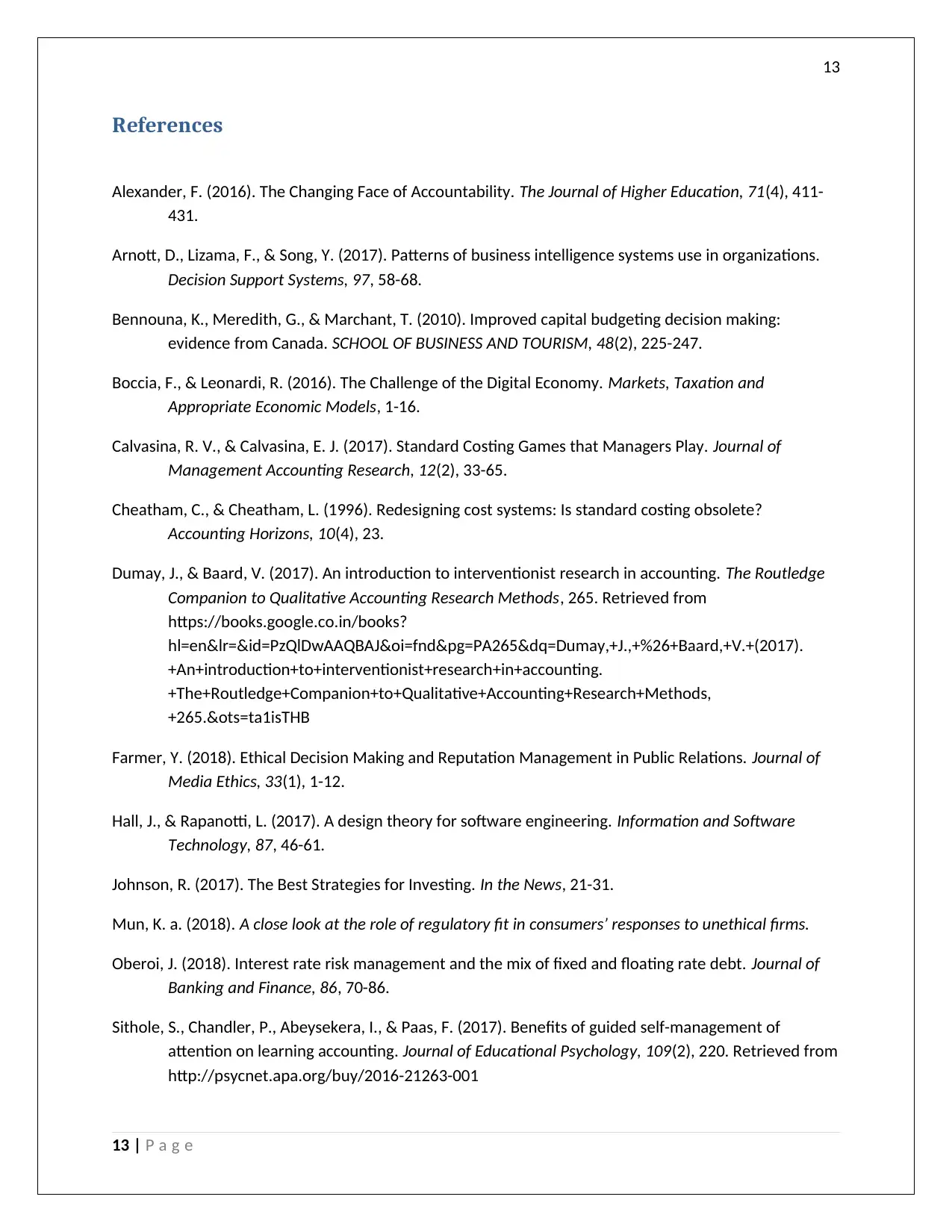
13
References
Alexander, F. (2016). The Changing Face of Accountability. The Journal of Higher Education, 71(4), 411-
431.
Arnott, D., Lizama, F., & Song, Y. (2017). Patterns of business intelligence systems use in organizations.
Decision Support Systems, 97, 58-68.
Bennouna, K., Meredith, G., & Marchant, T. (2010). Improved capital budgeting decision making:
evidence from Canada. SCHOOL OF BUSINESS AND TOURISM, 48(2), 225-247.
Boccia, F., & Leonardi, R. (2016). The Challenge of the Digital Economy. Markets, Taxation and
Appropriate Economic Models, 1-16.
Calvasina, R. V., & Calvasina, E. J. (2017). Standard Costing Games that Managers Play. Journal of
Management Accounting Research, 12(2), 33-65.
Cheatham, C., & Cheatham, L. (1996). Redesigning cost systems: Is standard costing obsolete?
Accounting Horizons, 10(4), 23.
Dumay, J., & Baard, V. (2017). An introduction to interventionist research in accounting. The Routledge
Companion to Qualitative Accounting Research Methods, 265. Retrieved from
https://books.google.co.in/books?
hl=en&lr=&id=PzQlDwAAQBAJ&oi=fnd&pg=PA265&dq=Dumay,+J.,+%26+Baard,+V.+(2017).
+An+introduction+to+interventionist+research+in+accounting.
+The+Routledge+Companion+to+Qualitative+Accounting+Research+Methods,
+265.&ots=ta1isTHB
Farmer, Y. (2018). Ethical Decision Making and Reputation Management in Public Relations. Journal of
Media Ethics, 33(1), 1-12.
Hall, J., & Rapanotti, L. (2017). A design theory for software engineering. Information and Software
Technology, 87, 46-61.
Johnson, R. (2017). The Best Strategies for Investing. In the News, 21-31.
Mun, K. a. (2018). A close look at the role of regulatory fit in consumers’ responses to unethical firms.
Oberoi, J. (2018). Interest rate risk management and the mix of fixed and floating rate debt. Journal of
Banking and Finance, 86, 70-86.
Sithole, S., Chandler, P., Abeysekera, I., & Paas, F. (2017). Benefits of guided self-management of
attention on learning accounting. Journal of Educational Psychology, 109(2), 220. Retrieved from
http://psycnet.apa.org/buy/2016-21263-001
13 | P a g e
References
Alexander, F. (2016). The Changing Face of Accountability. The Journal of Higher Education, 71(4), 411-
431.
Arnott, D., Lizama, F., & Song, Y. (2017). Patterns of business intelligence systems use in organizations.
Decision Support Systems, 97, 58-68.
Bennouna, K., Meredith, G., & Marchant, T. (2010). Improved capital budgeting decision making:
evidence from Canada. SCHOOL OF BUSINESS AND TOURISM, 48(2), 225-247.
Boccia, F., & Leonardi, R. (2016). The Challenge of the Digital Economy. Markets, Taxation and
Appropriate Economic Models, 1-16.
Calvasina, R. V., & Calvasina, E. J. (2017). Standard Costing Games that Managers Play. Journal of
Management Accounting Research, 12(2), 33-65.
Cheatham, C., & Cheatham, L. (1996). Redesigning cost systems: Is standard costing obsolete?
Accounting Horizons, 10(4), 23.
Dumay, J., & Baard, V. (2017). An introduction to interventionist research in accounting. The Routledge
Companion to Qualitative Accounting Research Methods, 265. Retrieved from
https://books.google.co.in/books?
hl=en&lr=&id=PzQlDwAAQBAJ&oi=fnd&pg=PA265&dq=Dumay,+J.,+%26+Baard,+V.+(2017).
+An+introduction+to+interventionist+research+in+accounting.
+The+Routledge+Companion+to+Qualitative+Accounting+Research+Methods,
+265.&ots=ta1isTHB
Farmer, Y. (2018). Ethical Decision Making and Reputation Management in Public Relations. Journal of
Media Ethics, 33(1), 1-12.
Hall, J., & Rapanotti, L. (2017). A design theory for software engineering. Information and Software
Technology, 87, 46-61.
Johnson, R. (2017). The Best Strategies for Investing. In the News, 21-31.
Mun, K. a. (2018). A close look at the role of regulatory fit in consumers’ responses to unethical firms.
Oberoi, J. (2018). Interest rate risk management and the mix of fixed and floating rate debt. Journal of
Banking and Finance, 86, 70-86.
Sithole, S., Chandler, P., Abeysekera, I., & Paas, F. (2017). Benefits of guided self-management of
attention on learning accounting. Journal of Educational Psychology, 109(2), 220. Retrieved from
http://psycnet.apa.org/buy/2016-21263-001
13 | P a g e
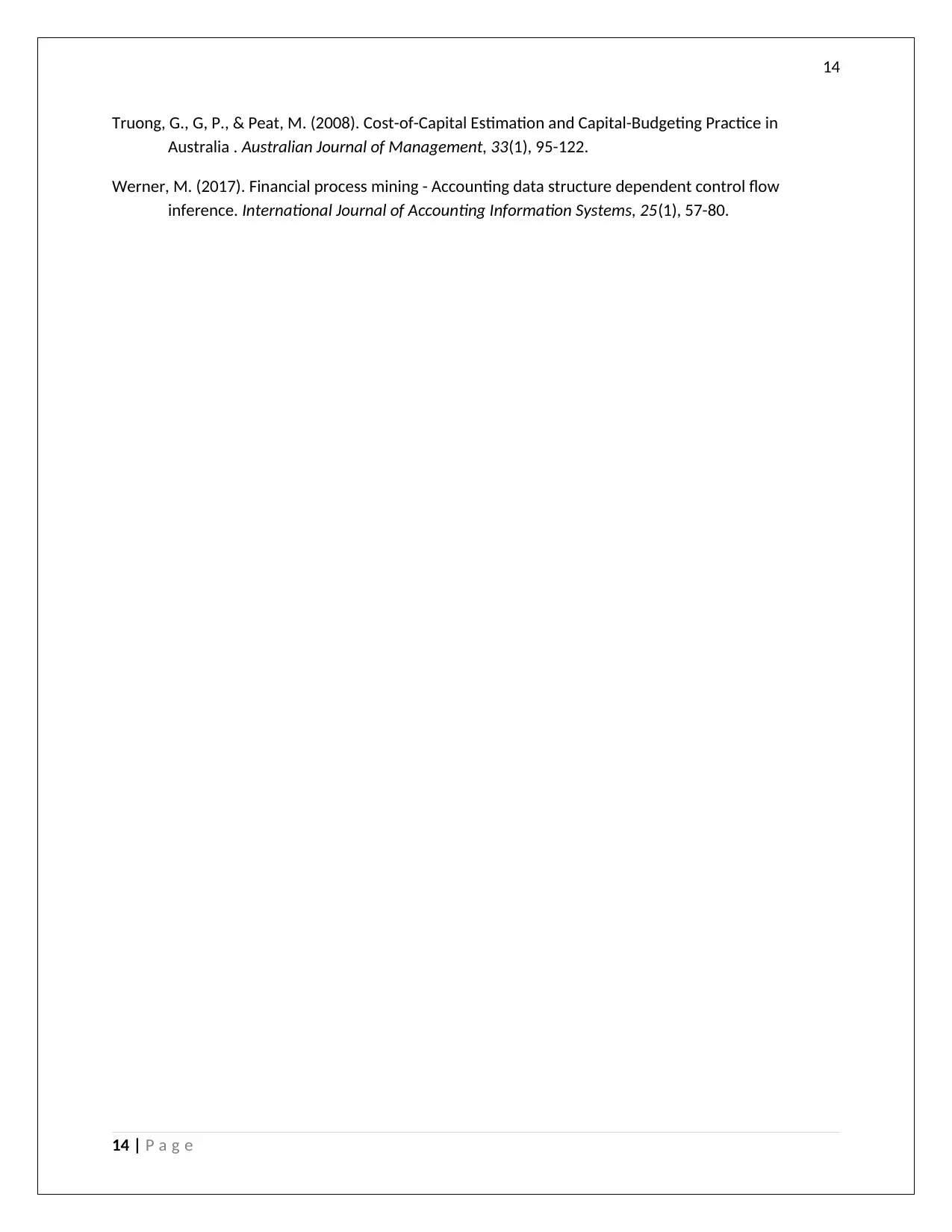
14
Truong, G., G, P., & Peat, M. (2008). Cost-of-Capital Estimation and Capital-Budgeting Practice in
Australia . Australian Journal of Management, 33(1), 95-122.
Werner, M. (2017). Financial process mining - Accounting data structure dependent control flow
inference. International Journal of Accounting Information Systems, 25(1), 57-80.
14 | P a g e
Truong, G., G, P., & Peat, M. (2008). Cost-of-Capital Estimation and Capital-Budgeting Practice in
Australia . Australian Journal of Management, 33(1), 95-122.
Werner, M. (2017). Financial process mining - Accounting data structure dependent control flow
inference. International Journal of Accounting Information Systems, 25(1), 57-80.
14 | P a g e
1 out of 15
Related Documents
Your All-in-One AI-Powered Toolkit for Academic Success.
+13062052269
info@desklib.com
Available 24*7 on WhatsApp / Email
![[object Object]](/_next/static/media/star-bottom.7253800d.svg)
Unlock your academic potential
© 2024 | Zucol Services PVT LTD | All rights reserved.



